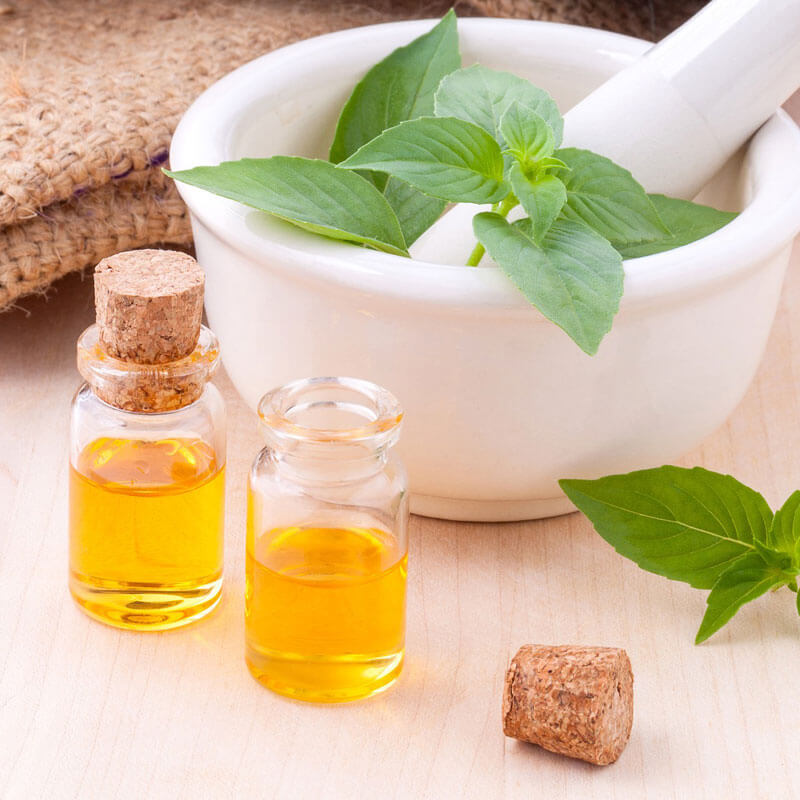Hyssop essential oils benefits typically don’t top the charts because it’s not typically the first that comes to mind. Yet as a fragrant shrub related to lavender and mint, its strong aroma and easy growth has drawn people to the hyssop herb for medicinal use since ancient times. Today, we can hyssop oil uses are known for their benefits on the digestive system and overall wellness.
In this article, you will learn about:
Hyssop Plant Profile
Hyssop is a member of the Lamiaceae (mint) family, and looks fairly similar to lavender. It is a perennial shrub in most growing zones, tolerant of a wide range of weather and drought conditions. (1)
Because it is native to southeastern Europe and the Mediterranean, the Greeks and Romans had great access to it, as reflected in their ancient uses. Like its relatives, the fragrant blossoms are harvested beginning in the summertime and used to make the distilled essential oil. Previous to true essential oil creation and today when the whole herb is preferred, whole stalks would be harvested for leaf and blossom use.
History of Hyssop Oil Uses
Cleanse me with hyssop, and I will be clean; wash me, and I will be whiter than snow.
~ Psalm 51:7
Hyssop joins the Biblical herbs and oils as a purifier, whose name actually means “holy herb.” It was used in rituals, teas, wound healing, and baths. David refers to hyssop in Psalm 51 as part of his repentant lament:
Cleanse me with hyssop, and I will be clean; wash me, and I will be whiter than snow.
It’s unclear whether Hyssop officinalis is the hyssop of the Bible – thyme and marjoram are strong contenders there – but the mention of cleansing aligns with other ancient uses of H. officinalis and could be why the Hebrew words were translated as such.
The healing and cleansing effects were not only used in topical and internal preparations of the herb, but through inhalation, as well. The stalks would be burned and the smoke inhaled for respiratory concerns. (2)
Today, the whole herb is still part of cleansing preparations as part of washes and cosmetic fragrances. The essential oil, however, is more commonly used since the herb itself has such a strong flavor. The fragrance lends itself to frequent adulteration with similar oils and fragrances, so choose your source carefully.
Hyssop Essential Oil Composition
With the exact composition of hyssop – and most essential oils – varying based on growth and harvest time and patterns, the compounds generally expected within hyssop essential oil include camphor, alpha- and beta-pinene, linalool, thujone, and pinocamphone, among others. (3) The decumbens variety is the most often used in essential oil and best to start with.
You’ll recognize some of those in other plants – lavender is rich in linalool, for example, and camphor explains the ancient use of smoke from burned hyssop for respiratory relief. Refer to Essential Oil Safety by Tisserand for details on the differences in chemical profiles.
3 Hyssop Essential Oil Benefits
While the overall composition of hyssop is beneficial, there are some cautions to take thanks to some compounds of it. Let’s start first with the beneficial actions.
1. Antiviral Action
It turns out, all of that ancient cleansing using hyssop was pretty much spot on. While the miasma theory that scent chased away illness isn’t exactly the mechanism of action, the idea was there and the application was close.
Hyssop essential oil has undergone a fair amount of research for its antiviral effects, as have some of its monoterpene constituents, such as the alpha- and beta-pinenes. Alongside other essential oils with shared compounds, hyssop has been demonstrated as effective against herpes simplex viruses in particular, apparently by interacting directly with the viral envelope and “disarming” it, so to speak. (4)
Indications: Topical preparations, hand cleansers, aromatic sprays for cleaning and disinfecting.
2. Antispasmodic
The term antispasmodic refers to slowing the spasms of muscles, which might apply to any number of conditions. Antispasmodics are, for example, sometimes used to soothe coughing fits and calm painful intestinal spasms. This aligns well with traditional uses of hyssop as a digestive “bitter herb” to stimulate even digestion or as a respiratory inhalation.
The antispasmodic effects of hyssop were studied in 2002, on tissue contraction in guinea pig intestines. (5) The muscle relaxing properties demonstrated could have effects on not only intestines and coughing but sore muscles, as well.
3. Digestive Health
The muscle relaxing benefits of hyssop seems to indicate the essential oil for digestive wellness. Adding a couple drops to your favorite carrier oil and rubbing over your stomach can do wonders. However, while some advocate internal use, do your homework because of the thujone and pinocamphone content; which are both considered problematic in different ways. We’ll look more at cautions momentarily, for now, the essential oil itself can soothe muscles in other ways.
Indications: Inhalation for respiratory issues, massage oils for muscle spasms and pain.
Cautions for Safe Hyssop Uses
While hyssop has many benefits, we are reminded that not all compounds of essential oils are universally safe or beneficial. The Epilepsy Society in the UK warns that hyssop oil is a potential risk for those with seizure disorders. (6) Pregnancy is a potential concern, as well, due to its effects as a uterine stimulant. (7)
The reason for these cautions lies in thujone and pinocamphone components. Thujone was once considered to be a neurotoxin, and the pair together were thought to accumulate in the body toward toxic effects. (8) In more recent studies, the concerns have fallen more toward controversy than not. (9)
For optimal safety while still obtaining digestive benefits, internal use of hyssop when not pregnant or prone to seizures is best limited to whole herb teas and preparations, which diffuse the concerning components throughout the herbal material.
The essential oil can still be utilized for inhalation and topical treatments in most cases with presumed safety.
Note on Seizures & Hyptertension
This is tough one for me to figure out because there’s virtually no research on this in the last 20 years and the only couple articles that I can find are case studies. (8) Nonetheless virtually every blog that I see on the topic state that hyssop is contraindicated for epileptics and people prone to seizures.
Same thing with hypertension. According to Tisserand “I believe that there is no case for contraindicating any essential oil in someone with high blood pressure. As well as closely examining the evidence above, I also refer to more recent research, which confirms that the four “Valnet oils” present no risk. The lack of compelling evidence is reason enough to let go of this chimera.” (10)
If these are areas of concern for you, please contact your physician before using hyssop.
Favorite Hyssop Essential Oil Applications
Revisit traditional applications of hyssop by clearing the air in a diffused blend. Citrus oils are also excellent antimicrobials and blend well with the herbaceous scent of hyssop.
- Clear your counters as well as the air with hyssop in an antimicrobial cleaner. Blend orange and clove with hyssop into an alcohol and water or witch hazel and water combination to spritz on surfaces, door knobs, and other sources of topical contamination.
- Soothe a nagging cough or clear uncomfortable nasal irritation with an herbal or essential oil steam of hyssop and lavender.
- Promote digestive wellness with hyssop’s antispasmodic and digestive stimulant properties – though a whole-herbal hyssop tea is most clearly indicated in this instance.
- http://www.gardening.cornell.edu/homegardening/scene825e.html
- https://academics.hamilton.edu/foodforthought/Our_Research_files/hyssop.pdf
- https://www.sigmaaldrich.com/life-science/nutrition-research/learning-center/plant-profiler/hyssopus-officinalis.html
- https://www.ncbi.nlm.nih.gov/pubmed/17976968
- https://www.ncbi.nlm.nih.gov/pubmed/11914956
- https://www.epilepsysociety.org.uk/complementary-therapies#.VmKllISWv6R
- https://books.google.com.ph/books?hl=en&lr=&id=UdcZ2bttXaMC&oi=fnd&pg=PR19&dq=&redir_esc=y#v=onepage&q&f=false
- https://www.ncbi.nlm.nih.gov/pubmed/7333081
- https://www.ncbi.nlm.nih.gov/pubmed/23201408
- https://roberttisserand.com/2010/08/can-essential-oils-raise-blood-pressure/







